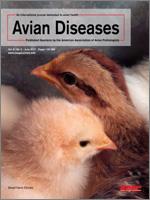The purpose of this study was to determine if Eimeria oocyst concentrations and species composition in commercial broiler house litter changed during different cycles of anticoccidial drug (ACD) or live Eimeria oocyst vaccine (VAC) control programs and if there was a correlation between Eimeria oocyst levels and broiler performance. Litter samples were collected from a total of 15 different broiler farms encompassing a total of 45 individual houses during at least one complete grow-out cycle over a 21-mo period. Of these 15 broiler farms, three were followed for the entire 21-mo period spanning three ACD and four VAC cycles. Samples were collected at 2, 4, and 7–8 wk of grow-out corresponding to starter, grower, and withdraw periods of the ACD cycle. On a number of occasions, litter samples were obtained just prior to chick placement. Eimeria oocysts were isolated from all samples, counted by microscopy, and extracted for DNA to identify Eimeria species by ITS1 PCR. In general, Eimeria oocyst concentration in litter reached peak levels at 2–4 wk of grow-out regardless of coccidiosis control measure being used. However, peak oocyst numbers were sometimes delayed until 7–8 wk, indicating some level of Eimeria spp. drug resistance or incomplete vaccine coverage. Eimeria maxima, Eimeria acervulina, Eimeria praecox, and Eimeria tenella were generally present in all samples, and no difference in the species composition was noted between houses on a particular farm. While Eimeria species composition was similar among houses, Eimeria spp. oocyst levels exhibited sporadic peaks in one house of a given location's houses. Of particular interest was the observed correlation between E. maxima oocyst abundance and chick mortality. However, no correlation was observed in E. maxima oocyst levels, and the performance parameters adjusted feed conversion ratio and average daily weight gain. This study showed that understanding the dynamics of Eimeria spp. oocyst levels and species composition in litter during ACD or VAC programs may provide insight into the effectiveness of coccidiosis control measures in commercial broiler production.
How to translate text using browser tools
9 March 2017
Eimeria Oocyst Concentrations and Species Composition in Litter from Commercial Broiler Farms During Anticoccidial Drug or Live Eimeria Oocyst Vaccine Control Programs
Mark C. Jenkins,
Carolyn Parker,
Donald Ritter
ACCESS THE FULL ARTICLE

Avian Diseases
Vol. 61 • No. 2
June 2017
Vol. 61 • No. 2
June 2017
anticoccidial drug
broiler
Eimeria
litter
oocysts
vaccine




